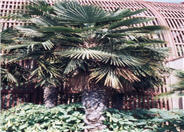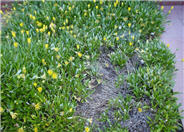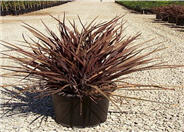
Common name:Chinese Pistache
Botanical name:Pistacia chinensis
The Pistacia chinensis is a deciduous tree with broad, spreading growth to 50' in height. Its leaves have 10-16 leaflets, and the fall coloring arrives in beautiful shades of red, orange and yellow. Prune young trees to shape. This tree does not have edible nuts. Female trees have tiny red fruit, turning dark blue. It prefers full sun and deep, infrequent waterings. This is a great street or park tree.

Common name:Windmill Palm
Botanical name:Trachycarpus fortunei
This easy-to-grow palm will mature to a size of 30', and its slender trunk is covered with dense, heavy fiber topped with a crown of rich green, fan-shaped leaves that could spread 8' wide. Once it's established, it needs low to medium watering. This is great palm for a tropical effect near the pool.

Common name:Semi-trailing Yellow Gazania
Botanical name:Gazania hybrid 'Mitsuwa Yellow'
This somewhat hardy perennial will grow 6"-12" high, spreading 3' wide. It produces wonderful, bright yellow flowers during the warm season. Plant in full sun. It is drought tolerant once it's established. This is a great ground cover for erosion control on hillsides or used as a lawn substitute.

Common name:Amazing Red Flax
Botanical name:Phormium 'Amazing Red'
Phormium 'Amazing Red' is an evergreen perennial. This plant has many swordlike, stiffly vertical leaves in a fan pattern, growing 1.5'- 2' tall. Leaves are reddish brown. Flowers are insignificant and bloom infrequently. It does better with occasional watering once it's established.
| Designer: Mariette Olsen | Parking Lot Color |
Photographer: GardenSoft |
Soils and Compost:
Incorporate compost 6" into your soil to retain water, reduce compaction, feed earthworms, and provide valuable nutrients to your plants.
Water Saving Tip:
Replace turf with groundcovers, trees, and shrubs. If you have areas where no one uses the grass, patches that do not grow well, or a turf area too small to water without runoff, consider replacing the turf with water-efficient landscaping.
Integrated Pest Management:
Remove irrigation water and fertilizer from areas where you don't want weeds to grow.
